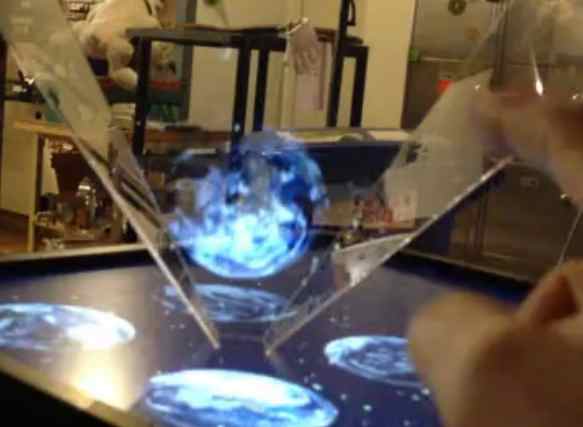| Easy 3D Display With Leap Control |
| Written by Ian Elliot | |||
| Wednesday, 03 April 2013 | |||
|
Now and again you see something that achieves a lot with very little. In this case we have an impressive, almost 3D, display created out of standard parts plus a Leap Motion sensor. This couldn't be more basic. The image of the globe is created using Three.js a JavaScript 3D graphics library that works with Canvas, SVG or WebGL. With JavaScript's speed increasing all the time, who knows, perhaps WebGL will be a redundant feature in the near future if we can render directly to Canvas.
In this case four views of the globe are created and reflected off the four sides of a plexiglass pyramid. The sides of the pyramid are angled at 45 degrees for correct horizontal viewing. Notice that there will be some distortion if viewed from slightly above or below. The display is simply a standard monitor laid flat on the table. The final touch is the use of the Leap Motion sensor interfaced with the JavaScript via a WebSocket. You can see that it does work and the globe rotates in response to the hand movements.
It looks good, but notice that it has its limitations. The image isn't a true volumetric display but four different views that you see depending on which side of the pyramid you are looking at. It is a nice idea implemented by Robbie Tilton. When you take into account how simple the approach is, you have to admit that it is remarkably effective. It also seems to be a demonstration that the Leap Motion controller is capable of doing real things - and via JavaScript. More InformationRelated ArticlesMyoelectric Input - Better Than Kinect? 3D Teapot Classic Using Pure DHTML A Browser For Work and Another For Play
To be informed about new articles on I Programmer, install the I Programmer Toolbar, subscribe to the RSS feed, follow us on, Twitter, Facebook, Google+ or Linkedin, or sign up for our weekly newsletter.
Comments
or email your comment to: comments@i-programmer.info
|
|||
| Last Updated ( Wednesday, 03 April 2013 ) |


